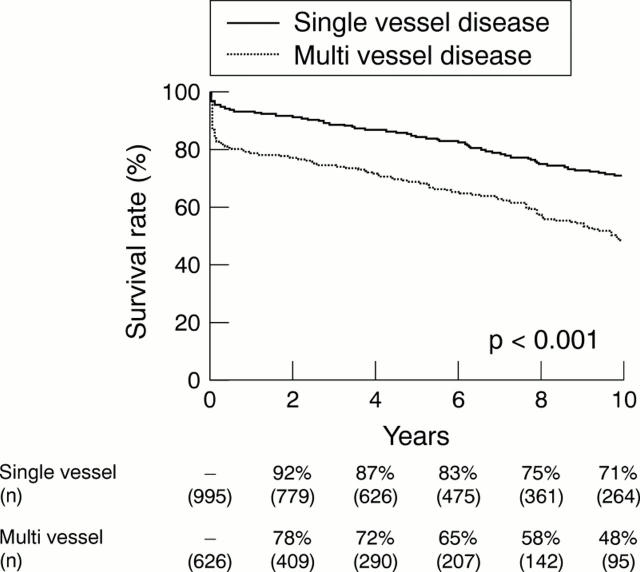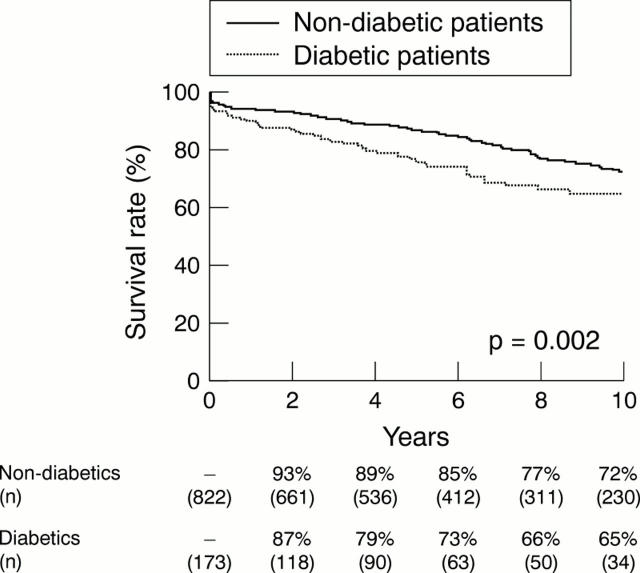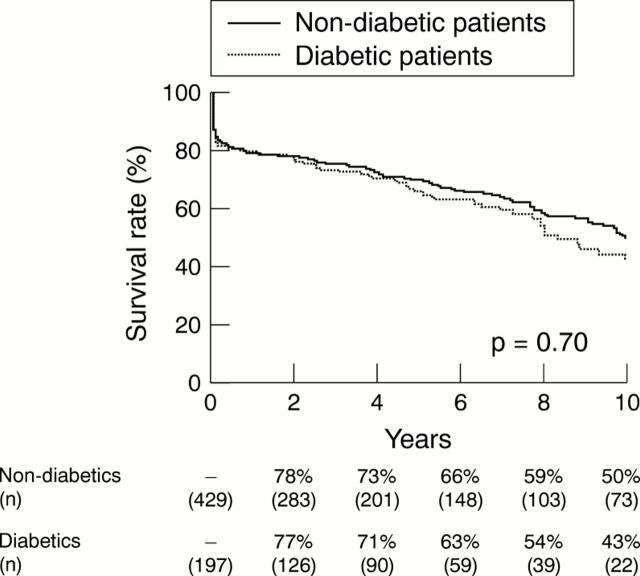Abstract
OBJECTIVE—To assess the influence of diabetes on long term prognosis after reperfusion treatment and its interaction with multivessel disease. DESIGN—A retrospective observational study. SETTING—Hiroshima City Hospital. PATIENTS—1660 consecutive patients with acute myocardial infarction who underwent coronary angiography within 24 hours after the onset of chest pain. MAIN OUTCOME MEASURES—Influence of diabetes on 10 year survival after infarction was assessed using the generalised Wilcoxon test and Cox's proportional hazards regression. Follow up was completed in 1622 patients (98%). RESULTS—Diabetic patients had more multivessel disease than non-diabetic patients (53% v 34%, p < 0.001). When only patients with single vessel disease were compared, diabetes was associated with a reduced 10 year survival after infarction (p = 0.002). On the other hand, in patients with multivessel disease there was no significant difference in survival between diabetic and non-diabetic patients (p = 0.70). Multivariate analysis also showed that diabetes was an independent risk factor related to 10 year mortality after infarction in patients with single vessel disease (odds ratio (OR) 1.81, 95% confidence interval (CI) 1.27 to 2.54; p = 0.001) and not in patients with multivessel disease (OR 1.17, 95% CI 0.85 to 1.60; p = 0.34). CONCLUSIONS—Diabetes is an independent predictor of long term mortality after infarction in patients with single vessel disease. However, in the presence of multivessel disease, prognosis after infarction is impaired regardless of diabetes, and the influence of diabetes is less obvious. Keywords: myocardial infarction; diabetes; coronary angiography
Full Text
The Full Text of this article is available as a PDF (143.6 KB).
Figure 1 .
10 year survival curves for all enrolled patients. Diabetic patients had significantly worse survival after myocardial infarction than non-diabetic patients.
Figure 2 .
10 year survival curves for all enrolled patients. Patients with multivessel disease had significantly worse survival after myocardial infarction than those with single vessel disease.
Figure 3 .
10 year survival curves for patients with single vessel disease. In these patients diabetes was associated with worse survival after myocardial infarction.
Figure 4 .
10 year survival curves for patients with multivessel disease. In patients with multivessel disease, survival after myocardial infarction was poor regardless of diabetes.
Selected References
These references are in PubMed. This may not be the complete list of references from this article.
- Anversa P., Sonnenblick E. H. Ischemic cardiomyopathy: pathophysiologic mechanisms. Prog Cardiovasc Dis. 1990 Jul-Aug;33(1):49–70. doi: 10.1016/0033-0620(90)90039-5. [DOI] [PubMed] [Google Scholar]
- Barbash G. I., White H. D., Modan M., Van de Werf F. Significance of diabetes mellitus in patients with acute myocardial infarction receiving thrombolytic therapy. Investigators of the International Tissue Plasminogen Activator/Streptokinase Mortality Trial. J Am Coll Cardiol. 1993 Sep;22(3):707–713. doi: 10.1016/0735-1097(93)90180-9. [DOI] [PubMed] [Google Scholar]
- Behar S., Boyko V., Reicher-Reiss H., Goldbourt U. Ten-year survival after acute myocardial infarction: comparison of patients with and without diabetes. SPRINT Study Group. Secondary Prevention Reinfarction Israeli Nifedipine Trial. Am Heart J. 1997 Mar;133(3):290–296. doi: 10.1016/s0002-8703(97)70222-9. [DOI] [PubMed] [Google Scholar]
- Cox D. A., Rogers W. J., Aguirre F. V., Forman S., Solomon R., Zaret B. L. Effect on outcome of the presence or absence of chest pain at initiation of recombinant tissue plasminogen activator therapy in acute myocardial infarction. The Thrombolysis in Myocardial Infarction Investigators. Am J Cardiol. 1994 Apr 15;73(11):729–736. doi: 10.1016/0002-9149(94)90872-9. [DOI] [PubMed] [Google Scholar]
- Granger C. B., Califf R. M., Young S., Candela R., Samaha J., Worley S., Kereiakes D. J., Topol E. J. Outcome of patients with diabetes mellitus and acute myocardial infarction treated with thrombolytic agents. The Thrombolysis and Angioplasty in Myocardial Infarction (TAMI) Study Group. J Am Coll Cardiol. 1993 Mar 15;21(4):920–925. doi: 10.1016/0735-1097(93)90348-5. [DOI] [PubMed] [Google Scholar]
- Henry P., Makowski S., Richard P., Beverelli F., Casanova S., Louali A., Boughalem K., Battaglia S., Guize L., Guermonprez J. L. Increased incidence of moderate stenosis among patients with diabetes: substrate for myocardial infarction? Am Heart J. 1997 Dec;134(6):1037–1043. doi: 10.1016/s0002-8703(97)70023-1. [DOI] [PubMed] [Google Scholar]
- Ishihara M., Sato H., Tateishi H., Kawagoe T., Shimatani Y., Kurisu S., Sakai K., Ueda K. Implications of prodromal angina pectoris in anterior wall acute myocardial infarction: acute angiographic findings and long-term prognosis. J Am Coll Cardiol. 1997 Oct;30(4):970–975. doi: 10.1016/s0735-1097(97)00238-6. [DOI] [PubMed] [Google Scholar]
- Kannel W. B., McGee D. L. Diabetes and cardiovascular disease. The Framingham study. JAMA. 1979 May 11;241(19):2035–2038. doi: 10.1001/jama.241.19.2035. [DOI] [PubMed] [Google Scholar]
- Mak K. H., Moliterno D. J., Granger C. B., Miller D. P., White H. D., Wilcox R. G., Califf R. M., Topol E. J. Influence of diabetes mellitus on clinical outcome in the thrombolytic era of acute myocardial infarction. GUSTO-I Investigators. Global Utilization of Streptokinase and Tissue Plasminogen Activator for Occluded Coronary Arteries. J Am Coll Cardiol. 1997 Jul;30(1):171–179. doi: 10.1016/s0735-1097(97)00118-6. [DOI] [PubMed] [Google Scholar]
- Mintz G. S., Painter J. A., Pichard A. D., Kent K. M., Satler L. F., Popma J. J., Chuang Y. C., Bucher T. A., Sokolowicz L. E., Leon M. B. Atherosclerosis in angiographically "normal" coronary artery reference segments: an intravascular ultrasound study with clinical correlations. J Am Coll Cardiol. 1995 Jun;25(7):1479–1485. doi: 10.1016/0735-1097(95)00088-l. [DOI] [PubMed] [Google Scholar]
- Mosseri M., Nahir M., Rozenman Y., Lotan C., Admon D., Raz I., Gotsman M. S. Diffuse narrowing of coronary arteries in diabetic patients: the earliest phase of coronary artery disease. Cardiology. 1998;89(2):103–110. doi: 10.1159/000006764. [DOI] [PubMed] [Google Scholar]
- Muller D. W., Topol E. J., Ellis S. G., Sigmon K. N., Lee K., Califf R. M. Multivessel coronary artery disease: a key predictor of short-term prognosis after reperfusion therapy for acute myocardial infarction. Thrombolysis and Angioplasty in Myocardial Infarction (TAMI) Study Group. Am Heart J. 1991 Apr;121(4 Pt 1):1042–1049. doi: 10.1016/0002-8703(91)90661-z. [DOI] [PubMed] [Google Scholar]
- Rentrop K. P., Cohen M., Blanke H., Phillips R. A. Changes in collateral channel filling immediately after controlled coronary artery occlusion by an angioplasty balloon in human subjects. J Am Coll Cardiol. 1985 Mar;5(3):587–592. doi: 10.1016/s0735-1097(85)80380-6. [DOI] [PubMed] [Google Scholar]
- Singer D. E., Moulton A. W., Nathan D. M. Diabetic myocardial infarction. Interaction of diabetes with other preinfarction risk factors. Diabetes. 1989 Mar;38(3):350–357. doi: 10.2337/diab.38.3.350. [DOI] [PubMed] [Google Scholar]
- Waller B. F., Palumbo P. J., Lie J. T., Roberts W. C. Status of the coronary arteries at necropsy in diabetes mellitus with onset after age 30 years. Analysis of 229 diabetic patients with and without clinical evidence of coronary heart disease and comparison to 183 control subjects. Am J Med. 1980 Oct;69(4):498–506. doi: 10.1016/s0149-2918(05)80002-5. [DOI] [PubMed] [Google Scholar]
- Wong N. D., Cupples L. A., Ostfeld A. M., Levy D., Kannel W. B. Risk factors for long-term coronary prognosis after initial myocardial infarction: the Framingham Study. Am J Epidemiol. 1989 Sep;130(3):469–480. doi: 10.1093/oxfordjournals.aje.a115360. [DOI] [PubMed] [Google Scholar]
- Woodfield S. L., Lundergan C. F., Reiner J. S., Greenhouse S. W., Thompson M. A., Rohrbeck S. C., Deychak Y., Simoons M. L., Califf R. M., Topol E. J. Angiographic findings and outcome in diabetic patients treated with thrombolytic therapy for acute myocardial infarction: the GUSTO-I experience. J Am Coll Cardiol. 1996 Dec;28(7):1661–1669. doi: 10.1016/s0735-1097(96)00397-x. [DOI] [PubMed] [Google Scholar]
- Zarich S. W., Nesto R. W. Diabetic cardiomyopathy. Am Heart J. 1989 Nov;118(5 Pt 1):1000–1012. doi: 10.1016/0002-8703(89)90236-6. [DOI] [PubMed] [Google Scholar]
- Zuanetti G., Latini R., Maggioni A. P., Santoro L., Franzosi M. G. Influence of diabetes on mortality in acute myocardial infarction: data from the GISSI-2 study. J Am Coll Cardiol. 1993 Dec;22(7):1788–1794. doi: 10.1016/0735-1097(93)90758-s. [DOI] [PubMed] [Google Scholar]






